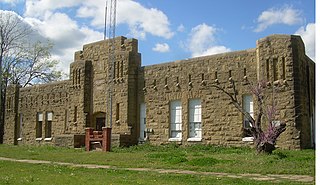
Armory Square is a small neighborhood on the west side of Downtown Syracuse, New York. It began life as a busy commercial and industrial area just to the west of the central city. After World War II, Syracuse's central city became less and less populated as more housing and business facilities were built in the suburbs. In the 1980s, plans were first made to transform the languishing district into a small shopping/arts/nightlife district surrounding the former Syracuse Armory. These plans came to fruition during the 1990s, when new stores and restaurants opened, and several new buildings were constructed in a compatible style to the middle and late 1800s and early 1900s architecture dominating the district.

Pawnee Rock, one of the most famous and beautiful landmarks on the Santa Fe Trail, is located in Pawnee Rock State Park, just north of Pawnee Rock, Kansas, United States. Originally over 150 feet (46 m) tall, railroad construction stripped it of some 15 to 20 feet (6.1 m) in height for road bed material. A memorial monument, picnic area, and pergola have been constructed on the top. From the top of the pergola is a view the Arkansas river valley and the route of the Santa Fe trail. Today it is a prominence rising 50 or 60 feet above the surrounding plains. Matt Field, who traveled the Santa Fe Trail in 1840, later wrote, "Pawnee Rock springs like a huge wart from the carpeted green of the prairie." Traders, soldiers, and emigrants who stopped, carved their names into the brown sandstone. Some of these names are still visible among the graffiti of the more recent visitors.

This is a list of the National Register of Historic Places listings in Oklahoma County, Oklahoma.

The National Guard Armory is a historic National Guard Armory located at Columbia, Missouri. It was built about 1940, as a Works Progress Administration project. The rectangular, reinforced concrete, Art Deco building sits on the north side of downtown Columbia. Today the building is owned by the city and used as a youth recreation center.

Amsterdam Castle, also known as the Amsterdam Armory, was built in 1895 by Isaac G. Perry, and is a former National Guard Armory located in Amsterdam, NY. Listed on the National Register of Historic Places in 1994. Amsterdam Castle was decommissioned in 1994, and purchased by the Diana family from the State of New York in 1995. In 2005 the Phemister family purchased the building, and continued the extensive renovation, utilizing green building techniques and energy efficient heat zoning in addition to creating a new residence wing, a billiard room and three new bathrooms. The property is currently in use as a private residence, bed and breakfast and distribution facility. Of the 100 armories built in New York at the turn of the century, only several dozen are still in use as active armories, and Amsterdam Castle is the only armory converted into a private residence.

This is a list of the National Register of Historic Places listings in Pawnee County, Oklahoma.

The Corliss Steam Engine on the Pawnee County Fairgrounds in Pawnee, Oklahoma is a Corliss steam engine that was built c. 1912. It and a twin sister engine were originally built for the Blackwell Zinc Co., of Blackwell, Oklahoma. It powered most of the electricity-powered machinery in the 1000-employee zinc smelter plant until the plant closed in 1973.

The Enid Armory was located in Enid, Oklahoma and has been listed on the National Register of Historic Places since 1988. The two story building was constructed in 1936 as a Works Progress Administration project. It was the third largest Armory in Oklahoma.

Pahuk, also written Pahaku, or Pahuk Hill, is a bluff on the Platte River in eastern Nebraska in the United States. In the traditional Pawnee religion, it was one of five dwellings of spirit animals with miraculous powers. The Pawnee occupied three villages near Pahuk in the decade prior to their removal to the Pawnee Reservation on the Loup River in 1859.

The Gettysburg Armory is a former National Guard armory located at Gettysburg, Adams County, Pennsylvania. It was listed on the National Register of Historic Places in 1990. The 61x96 ft Art Deco facility was constructed as a $43,331 Works Projects Administration project for the local National Guard unit. The two story building housed a garage and repair shop for military vehicles, a classroom, administrative space, and a drill hall. From the beginning, the Armory was used not only by the National Guard, but also by the local community, for sporting events and community meetings. In 1944, the Gettysburg Armory was used as a temporary German Prisoner of War camp while the official camp was being constructed on the Gettysburg Battlefield. Later the building was designated as a public fallout shelter by the National Fallout Shelter Survey.

Bryan W. Nolen was an Oklahoma City, Oklahoma architect who served as a Major in the Oklahoma National Guard. He designed numerous armories built under the Works Progress Administration. He is credited with more than 20 buildings that are preserved and listed on the National Register of Historic Places.

Carlisle Armory is a historic National Guard armory located at Carlisle, Cumberland County, Pennsylvania. It was built in 1931, and consists of separate administration and stable buildings executed in the Colonial Revival style. It was designed by architect Thomas H. Atherton. The administration building is a two-story stone and brick building with a gable roof and two arched dormers. The side gables feature Palladian windows. The stable building is a one-story, gambrel roofed building with gable dormers. The stable building has been converted to offices, classrooms, locker rooms, and storage.

East Stroudsburg Armory, also known as the Captain George M. Kemp Memorial Armory, is a historic National Guard armory located at East Stroudsburg, Monroe County, Pennsylvania. It was built in 1928, and is a "T"-plan building consisting of a two-story administration building and attached one-story drill hall executed in the Tudor Revival style. It is constructed of brick and sits on a concrete foundation. It measures approximately 56 feet by 128 feet.

The Pawnee Agency Office and Superintendent's House are two of several buildings located in the 29-acre Boarding School Historic District in Pawnee, Oklahoma. Both were awarded National Historic Place status in 1973. The surrounding district was awarded National Historic Place status in 2000.

The Pawnee Municipal Swimming Pool and Bathhouse were erected by the Federal Emergency Relief Administration (FERA) and the Works Progress Administration (WPA) in the 1930s. The swimming pool, built in 1937, covers three acres. The Bathhouse was constructed in 1939 of native stone. The west side of the bathhouse is one-story and is typical of WPA-built buildings in the state, while the east side is two-story and more elaborate.

The Arkansas Valley National Bank, constructed in 1902, is a two-story, 30 feet x 90 feet sandstone structure located in Pawnee, Oklahoma. Constructed in a Late Victorian architectural style, it was Pawnee's original bank. When the building opened, the bank occupied the first floor, while a doctor, photographer, and local telephone office occupied the second floor. The bank closed around 1918, and the building has served as various storefronts since.

The Pawnee County Courthouse is a three-story art deco brick building that is still functioning as a courthouse. Four bas-relief panels on either side of the entrance on the south side depict scenes of Native Americans and pioneers, while the lintel depicts an eagle, a cow's skull, an owl, an open book and two rattlesnakes. The west end has a lintel like the one on the south side. The north side of the courthouse as another four panels, two of Native Americans and two of pioneers. Across the top of the building are heads of Native Americans.

The Idabel Armory in Idabel, Oklahoma was built in 1936 as a Works Progress Administration (WPA) project. It was listed on the National Register of Historic Places in 1988.

The State Arsenal and Armory, formally the Governor William A. O'Neill State Armory and informally the Connecticut State Armory, is a historic military facility at 360 Broad Street in Hartford, Connecticut. Built in 1906, it is a distinctive example of Classical Revival architecture, built using then-innovative construction techniques involving concrete and cast stone. It was listed on the National Register of Historic Places in 1996. It serves as the headquarters of the Connecticut State Militia.

The Holdenville Armory, at US 270 and N. Butts St. in Holdenville, Oklahoma, was built in 1936. It was listed on the National Register of Historic Places in 1936.



























